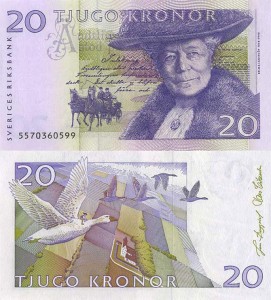Embarrassing though it may be to admit, when I started this internship, I had never heard of any of the women writers mentioned in the conference programme. I knew neither their names nor their achievements in the literary world or political arena. My starting point was to search in the university library’s search function to see whether I could find any information about the authors who were the subjects of the conference. There was little information available in the women writers’ native languages and the amount of material in English was also scant. However, one name wielded several results and so I headed for the Scandinavian section of the library where I went along the shelves containing Selma Lagerlöf’s novels. I picked up a novel titled The Wonderful Adventures of Nils and borrowed it. Arriving home, I opened the book at the first page and realized why the title rang a bell.
Selma Lagerlöf’s novel tells the story of a disobedient boy whose travels across Sweden on the back of a goose help him become more responsible. In 1902, she was commissioned by the National Teachers Association to write a geography and history book for children. To this end, she devoted three years to familiarizing herself with animal and bird life and incorporated previously unpublished folklore from various different Swedish provinces into her novel. The Wonderful Adventures of Nils was an instant success, not only in Swedish public schools, but also across the world. Nils and his creator are still an integral part of 21st-century Swedish life since as he is depicted on the back of the Swedish 20 crown note while Lagerlöf appears on the front. Nils Holgersson’s adventures were adapted for TV, broadcast all over the world from Russia to Japan and from Canada to Germany. And that’s how I first made Nils’s acquaintance. It was one of the animated series which I loved watching as a child.
Selma Lagerlöf was not only the first Swede to be awarded the Nobel Prize for Literature in 1909, but she was also the first woman to receive the prize for her achievements. Considering her standing and the popularity of her works it comes, in fact, as no surprise that I did know Selma Lagerlöf. I was just not aware of it. So, as this conference aims to demonstrate, connections can be found almost anywhere, and my link to Selma Lagerlöf is through a novel about a badly behaved boy and my favourite children’s television series.
But my bond with Lagerlöf and her mischievous hero is only one personal example. The network linking women writers, spans across regions and countries, connecting women writers all around Europe and further afield. As novelists, publishers, journalists or activists, their influence was far-reaching. Let us look at one example: For the exhibition, we have been translating dedications inscribed in books found in Emilia Pardo Bazán’s library in her Spanish hometown. People from all over the world wrote to a woman who was one of the most renowned 19th-century Spanish writers. Writers from Spain, Latin America (Argentina, Chile, Colombia, Costa Rica, Cuba Ecuador, Peru, Puerto Rico, Mexico, Uruguay), Portugal, France, Romania, the UK and the US dedicated their publications to Pardo Bazán, highlighting the wide network surrounding this particular woman writer. It made me wonder why this writer’s popularity has not endured until today outside Spain and why her work has been largely neglected. Considering how ground-breaking and impactful Pardo Bazán’s work was, and how influential many other women writers were, it is startling to discover that finding information about them or translations of their works is a difficult task.
It is frustrating to realize that women writer’s names and works are not held in the same esteem as their male counterparts because they are relegated to the side lines. Out of sight, out of mind. The great thing about this conference is that academics from all over Europe and beyond are coming together to present their papers and findings and, of course, to give these women writers a voice. The longer I participate in the conference preparation, the more interested I become in the writers. In many cases, their lives and their impact at the turn of the 19th century would lend themselves to film adaptations. But, for now, a map at the exhibition will visualize their influence and interaction. I don’t want to give too much away but, suffice to say, this part of the conference exhibition aims to create a multi-coloured medley of networks. So, come along to “Cultural Encounters through Reading and Writing: New Approaches to the History of Literary Culture” conference at Glasgow Women’s Library from the 9 – 11 June. Who knows, you might discover a connection yourself!
